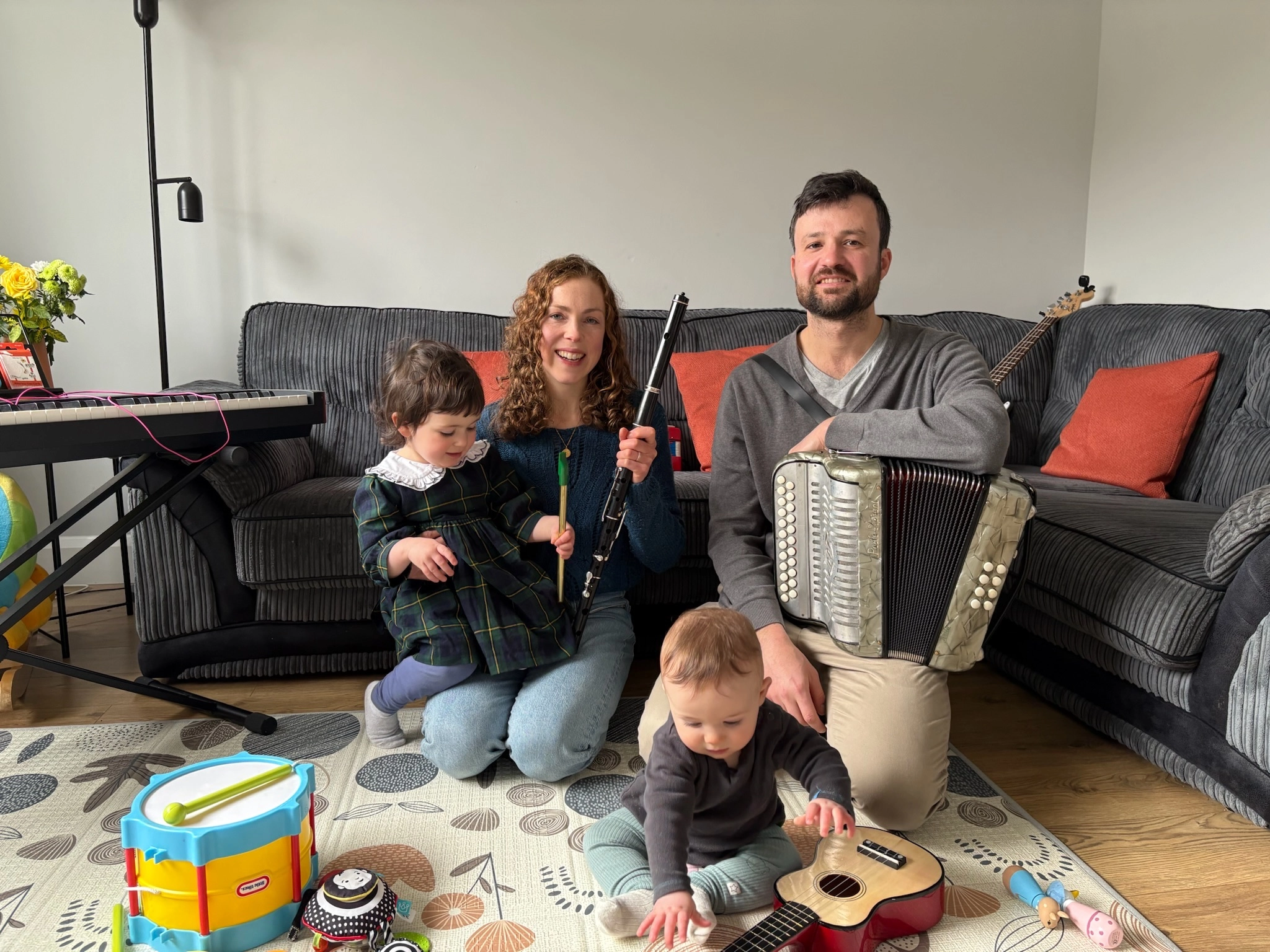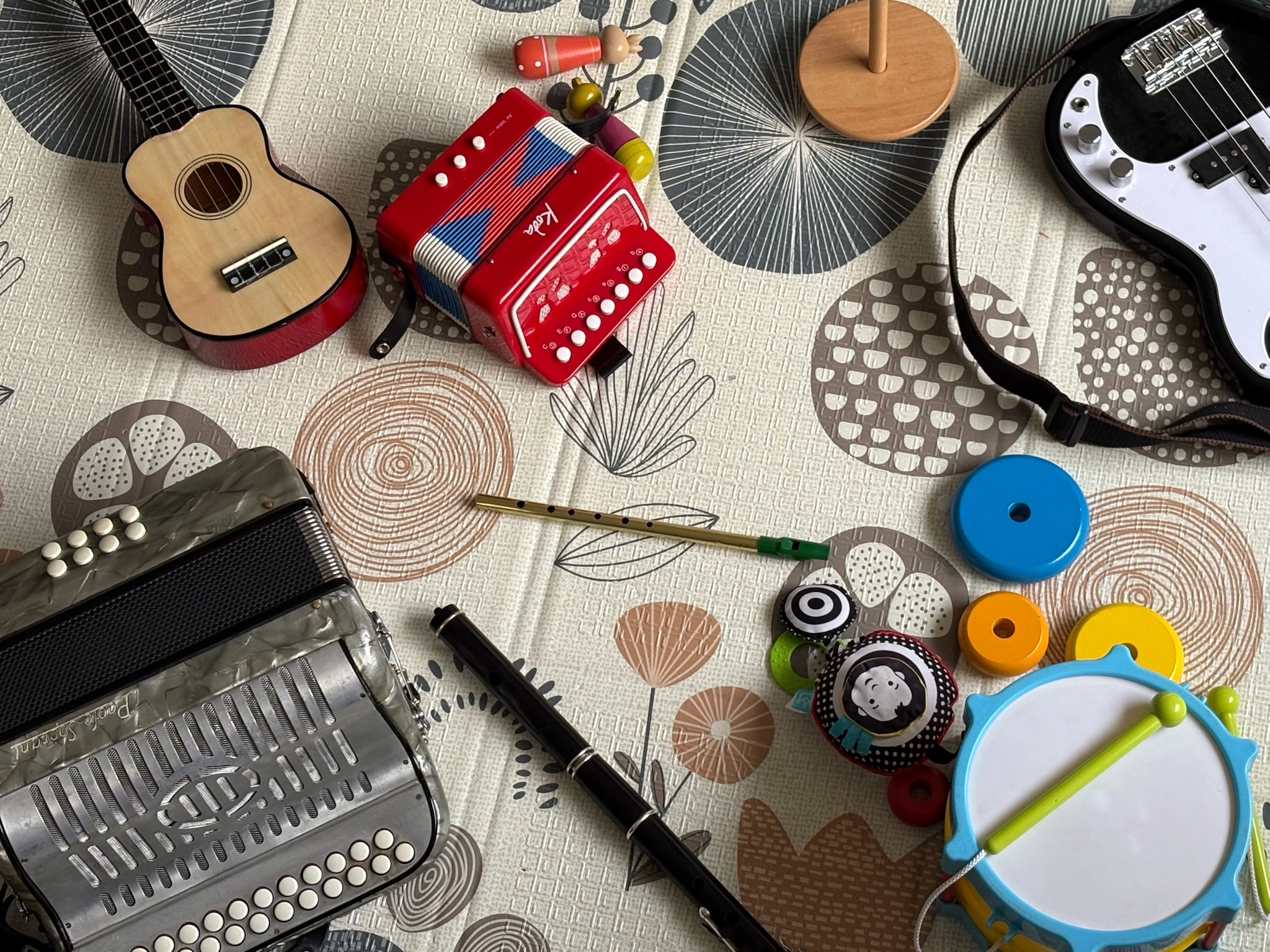Introduction to Dan Gurney & Christina Dolphin
Dan Gurney learned his music in the Hudson Valley, just north of New
York City, from senior immigrant musicians, most notably the late
Roscommon flute player Mike McHale and east-Galway multi-instrumentalist
Fr. Charlie Coen. When he moved to Dublin a few years ago, Dan brought
with him a musical sensibility absorbed from those 1950's exiles,
playing his vintage button box in an older, more relaxed style than that
of many of Ireland's contemporary young traditional musicians.
It is a style that nonetheless meshes beautifully with the smoothly
flowing flute and whistle playing of his wife Christina Dolphin and with
Brian McGrath's tastefully understated piano accompaniment. Christina,
like many globe-trotting Irish musicians of her generation, spent a few
years abroad, including a residency in New Paltz, New York (with a gig
as a Broadway theater musician), before returning home to raise a
family.
Dan and Christina are fondly remembered in the Empire State, so even if
the streets of Dublin are a bit farther than a subway ride away, we
Yanks can only hope that the ties that bind them to New York will draw
them back for visits in years to come!
Don Meade, Samsonville, NY
Notes
1. Teampall an Ghleantáinn / Buckley's Fancy (Reels, 2:49)
We learned the first tune from Mick O'Brien and Caoimhín Ó
Raghallaigh's classic recording
Kitty Lie Over. It refers to a village in Limerick and is reputed to be from the
playing of Denis Murphy. Buckley's Fancy was a favorite of
Father Charlie Coen, who sadly passed away at the end of 2024. He was Dan's main
influence growing up and passed down a multitude of East Galway tunes
like this. He often started performances with this tune. It was also
recorded on Warming up by Father Charlie's brother Jack along with
Séamus Connolly, Martin Mulhaire, and Felix Dolan - legends all!
2. The Fleadh at Tulla / The Skeleton Key (Single Jigs, 3:16)
We learned The Fleadh at Tulla from Séamus Connolly's wonderful
Collection of Irish Music published online by Boston College. There are countless lesser-known
gems in this collection, all freely available with accompanying recordings
and sheet music. The Skeleton Key was named by the inimitable uilleann
piper Seán McKiernan. It comes from the playing of Micho Russell as well
as Dermot Grogan and is sometimes known as "Come into the Town My Fair
Lady."
3. Byrne's Hornpipe / Galway Bay (Hornpipes, 2:58)
During the seemingly endless days of the Covid lockdowns in Ireland,
we often circulated voice memos of tunes that came into our heads.
This is one of them. It's not
really Byrne's Hornpipe, and instead
seems to be a mashup of various tunes that presented itself to Dan one
day. But anyway,
Byrne's is the closest tune we could find and it's clearly where the second part
was stolen from! Galway Bay, meanwhile, is associated with the west of
the country and has been recorded by Paddy Carty, Conor Tully, and Frank
Hogan, as well as Joe Burke and Charlie Lennon.
4. Lament for a Fiddler (Slow Air, 4:14)
This is a composition of the great flute-player Josie McDermott.
Christina learned it from Dublin flute player Sarah Jane Woods, who
was one of many great teachers she was fortunate to take lessons from
in her youth, and first sparked her interest in slow-air playing by
connecting them to the songs, singers or musicians from which they
came.
5. The Sligo Reel / Tommy Coen's / Jimmy Giblin's (Reels, 3:26)
Dan learned The Sligo Reel from
Memories from the Holla, a landmark album recorded by Peter Carberry, Angelina Carberry, and
John Blake. It may have been composed by Sligo flute player
James Murray from Ogham near Tubbercurry. Christina learned Tommy Coen's reel from
flute player June McCormack, who was one of her main influences growing
up. Tommy Coen's is a composition of the Urrachree fiddle player who worked
as a
conductor on Connemara buses and often kept a fiddle under the back seat. It is usually played in
G minor, but here we bring it down to E minor. Dan learned Jimmy Giblin's
from accordion player James Keane, born in Drimnagh and now a staple of
the Irish music scene in New York City. James recorded this tune on his
album
Heir of the Dog and adds a great bounce to the first phrase.
Lad O'Beirne also played a version of this tune.
6. Mick Moloney's / The Dark East Dream (Barndances, 2:59)
Both of us spent memorable times in the company of
Mick Moloney, one of the most energetic and entertaining people we have ever met.
It was always "miles of smiles" when you were in Mick's company. Mick
also had high standards and wherever he went, made sure that Irish
music received the respect it deserves. Probably no one had more of an
impact on Irish music in America than Mick. Whether you look into the
Smithsonian Folklife Festival, Catskills Irish Arts Week, Cherish the
Ladies, Father Charlie and Jack Coen's album The Branch Line, or –
indeed nearly any festival, band, or recording that happened in the
states in the past 50 years – you will find Mick somewhere nearby! We
learned these two barndances for a performance with Mick and Athena
Tergis at the Irish Arts Center in New York City. Sadly we lost Mick
in 2022 but his legacy lives on.
7. Buck Mulligan's Hornpipe / An tSeanbhean Bhocht (Hornpipes, 3:38)
I was honored when the Irish Traditional Music Archive in Dublin asked
me to
compose a group of new tunes as part of their Saothar series. This is one of them, prompted by memorable
post-lockdown sessions in Buck Mulligan's pub in Dún Laoghaire. An tSeanbhean
Bhocht comes from the playing of Séamus Ennis and more recently from a
session in McNeill's Pub on Capel Street with Pádraic Keane, Maitiú Ó Casaide,
and Pádraig Ó Dubhgaill.
8. Gallagher's Frolics / The Coast Road (Jigs, 2:20)
This set of jigs was frequently played at the Saturday night session
in the Cultúrlann, Monkstown, where Christina first learned her music.
The second one in particular reminds her of the late Brendan McCabe, a
great flute and tin whistle player and a gentleman from Sligo from
whom she learned many tunes, and who taught her the importance of
learning by ear.
9. Rigney's / The Flowing Bowl / Ashmolean House (Reels, 3:25)
The first reel comes from one of our all-time favorite albums,
The Banks of the Shannon, by Séamus Connolly, Paddy O'Brien, and Charlie Lennon. The Flowing
Bowl was recorded by Irish-American band Solas in 1996 on their
self-titled debut album. Tommy Gunn, the fiddle player from Fermanagh and Belfast, composed
Ashmolean House. Dan learned it from Jerry O'Sullivan who recorded it
on
The Invasion alongside Séamus Egan and Mick Moloney.
10. An Buachaillín Bán (Slow Air, 4:01)
Christina learned this air from the singing of Nioclás Tóibín
(1928-1944) on his CD Rinn na nGael. Nioclás was from the parish of
Rinn Ó gCuanach in the County Waterford Gaeltacht (na Déise) which is
noted for its distinctive style of sean-nós singing. "An Buachaillín
Bán" was composed by the great scholar Éamonn Ó Donnchadha (1874-1949)
from Glenn, Carrig na Fear in County Cork. It is a late example of a
Political Aisling or Dream - a convention practiced by Munster poets
during the 18th century in which a political message is disguised as a
love song. Here, the protagonist's mind is in turmoil because she is
soon to be banished from Ireland. She mourns the states of Ireland,
and prays that "John" be vanquished and his rule here destroyed, as he
banished her people to exile in hundreds, and caused her to lose her
Fairheaded Boy.
11. Garryowen / The Chicago (Jigs, 4:20)
Dan originally learned Garryowen from
Patsy Touhey but was again reminded of it by brilliant fiddle player
Aidan Connolly at a session in Dún Laoghaire. The Chicago, meanwhile, comes from the
playing of Sligo-based band
Dervish.
12. Tomeen O'Dea's 1 and 2 (Reels, 2:12)
We finish with two reels from the playing of Roscommon flute player
Mike McHale who was a huge inspiration for Dan as a kid and teenager in upstate New
York. Mike organized the Catskills Ceili Band with local upstate musicians
– notably not including Dylan Foley, whose feet at the time did not touch
the floor when he sat on a chair! In addition to being a brilliant teacher
and
composer, Mike was an unfailingly generous man who was a pillar of the
upstate music scene alongside Father Charlie Coen.

